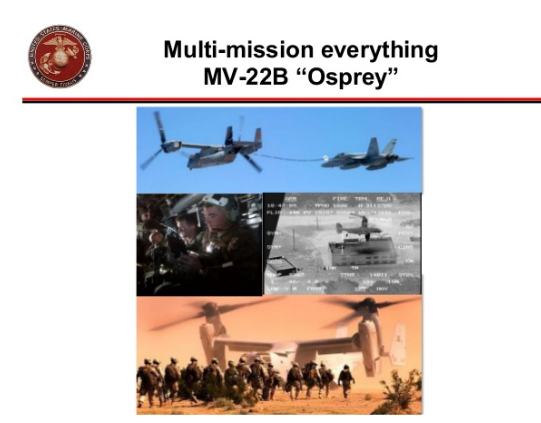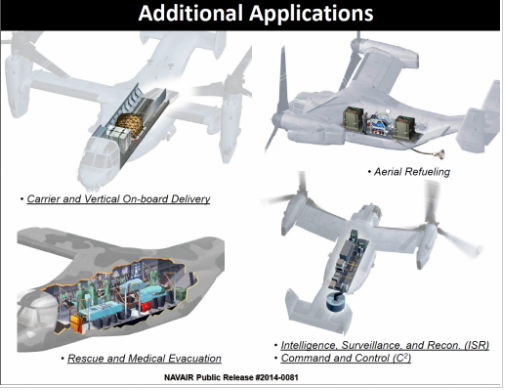2016-05-06 By Robbin Laird
When Lt. General Davis, the Deputy Commandant of Aviation spoke at the Williams Foundation seminar on new approaches to air-land integration, he described a key aspect of the evolving Marine Corps approach with their air assets as “multi-mission everything”.
Technology is important to this effort, and he highlighted that the Osprey being brought into the force was a generator of “disruptive change,” but the kind crucial to real combat innovation.
“But change is difficult; and the critics prevalent.”
He noted that if we held this conference 12 years ago, and the room was filled with Marines we would hear about all the things the Osprey could not do and why we should not go ahead. “If we brought those same Marines into the conference room now, they would have amnesia about what they thought then and press me to get more Ospreys and leverage it even more.”
But it is not just about technology – it is about “equipping Marines, not manning the equipment.”
His point was that you needed to get the new equipment into the hands of the Marines at the earliest possible moment, because the young Marines innovate in ways not anticipated when the senior leadership gets that equipment to them.

Clearly, Harvest Hawk is a key example for the KC-130s and the multi-missionization of the Osprey is another.
It is not hard to see the advantage of an Osprey refueling role for F-35Bs operating off of a forward engaged large deck amphibious ship like the USS America for its initial operations and support for the insertion of force.
And of course, the Osprey can be refitted rapidly for its other roles.
When we visited the Boeing plant, the multi-mission approach to the Osprey was highlighted during the visit.
The Osprey has redefined assault forces, and has led to the creation of new approaches to amphibious assault.
Now with multi-mission capabilities becoming available, the range of capabilities available to the assault force is broadened.
This is particularly significant as the amphibious strike force is redefined and able to carry organic capabilities hitherto only available to a large deck carrier.
During the visit to the Boeing V-22 Osprey plant at Boeing’s Philadelphia site, the Boeing team explained the range of possibilities for the Osprey adding multi-mission roll-on-roll off capabilities.
In the slide below the core capabilities being worked are highlighted.

Indeed, an example of the flexible uses of the V-22 were illustrated during the USS WASP-F-35B integration tests
The F-35B engine is modular, and the Osprey brought the largest module directly onboard solving any question of supplying engines for the F-35B underway on a large deck amphib or carrier for that matter.
What is being worked in the near term is the aerial refueling piece.
The USMC clearly wishes to add aerial refueling to its Ospreys to work with the F-35Bs and Harriers aboard their large deck amphibious ships.
Obviously, this adds organic capability, which expands the initial insertion options for the USN-USMC team. It also opens up possibilities of change for the large deck carrier community as well, both US and worldwide.
The capability is important, but equally interesting is the approach Bell-Boeing has developed to prepare for the possible introduction of air refueling.
During the visit to the factory, a visit to the multi-mission lab and a discussion with Ted Bayruns, Associate Technical Fellow and V-22 Modernization Lead Engineer, highlighted the very innovative approach being taken.
Basically, through the use of a 3-D Virtual Reality simulation facility in which human operators are inserted during requirements definition, the process of shaping an onboard aerial refueling system is crafted whereby adjustments can be made early to the system to optimize it in terms of potential operator use.
This means that validated requirements can feed to the preliminary and detailed design phases.
Continuous use of the lab throughout the remaining engineering development tasks supports “in-process” evaluation of prototypes which are incorporated as requiredto the baseline. Instead of taking years, months are required to get an initial design right.
During the visit, Douglas Fischer, Boeing V-22 Lead Human Factors Engineer, described how Boeing is using virtual reality to reduce the engineering cycle time, reduce program cost, and improve system integration.:
“Boeing Philadelphia has used virtual reality for years to support a variety of projects and programs, but primarily for concept development and design reviews.
We are now developing tools and capabilities with the VARS program to use virtual reality technology within the systems design engineering model.
The traditional systems engineering model completes processes such as requirements development, design definition, design reviews, testing and verification in a sequential manner.
Using a virtual reality rapid prototyping model allows us to simultaneously conduct the systems engineering processes.
This means we are able to support concept development, requirements verification, design reviews, and testing processes at the same time.
And then we can not only develop a workspace that’s suitable for the operators, but we can also start developing installation procedures and maintenance tasking.
The modification to our systems engineering supports rapid decision making and eliminates integration errors, reduces program costs, and enables us to support accelerated schedules for the USMC…..”
Bringing the con-ops into the design process is also an advantage, which can be facilitated by the new approach.
Fischer concluded:
“We weren’t really sure how they were going to use this tanking equipment, so we brought out our operators and air cabin and aircrews, and we developed the CONOPS with them.
We’ve never done that in a design review or technical meeting before.
We’re actually able to come here, immerse the operators in the virtual environment, and go step-by-step through the procedures, and identify, add, delete, the procedures based on their inputs on how they’re actually going to use the equipment.
This approach provides a unique and informative understanding of whether the proposed concepts are usable and allows the operators to complete their jobs.
We don’t define our customer’s requirements and conops…we invest to mature potential capabilities.”
In other words, the Osprey is entering the next phase of its development, a multi-mission phase.
https://sldinfo.com/the-next-phase-for-the-v-22-multi-missionization/
Now at Edwards AFB, the F-35B has done an initial test with the Osprey for a tanking role.
According to Kenji Thuloweit 412th Test Wing Public Affairs
4/29/2016 – EDWARDS AIR FORCE BASE, Calif. — A U.S. Marine Corps MV-22B Osprey descended on Edwards to link up with a Marine F-35B Joint Strike Fighter April 28.
Both aircraft are assigned to Marine Operational Test & Evaluation Squadron 22 (VMX-22) out of Marine Corps Air Station Yuma in Arizona.
VMX-22 has a detachment here where Marines are testing and evaluating their version of the JSF, which is the short take-off and vertical landing variant.
The Osprey dropped by for a quick but important test.
“The test was to validate ground refueling from an MV-22 to an F-35B, which is integral to the construct of the Marine Air Ground Task Force,” said USMC Maj. Adam Geitner, pilot and VMX-22 F-35 Detachment Aircraft Maintenance officer.
The Marine Air-Ground Task Force is the organizational foundation for all missions across the range of USMC military operations. MAGTFs are a balanced air-ground, combined arms task organization of Marine Corps forces under a single commander that is structured to accomplish a specific mission.
“This was the first time an MV-22 has refueled an F-35. Both ground refueling and air-to-air refueling are important pieces to the Marine Corps’ MAGTF operational construct. From a tactical point of view, the MV-22 to F-35 ground refueling allows the Marine Corps to employ assets in austere environments on a short notice without having to rely on long-term planning and fixed facilities,” Geitner said.
The one-hour test consisted of hooking up fuel transfer lines between the two aircraft with the MV-22 fueling up the F-35B. The test validated the equipment and procedures on both the F-35B and MV-22.
Geitner said the MV-22 Osprey has the ability to carry approximately 10,000 lbs. of fuel in its fuel containers loaded in the back of the aircraft. This is coupled with approximately 12,000 lbs. carried internally, which can either provide fuel to its own aircraft or to external aircraft in air-to-air refueling operations.

Fuel was successfully transferred to the F-35, which taxied off back to the Joint Operation Test Team area.
“The next step will be air-to-air refueling from an MV-22. This is even more significant for the MAGTF when operating F-35s from [amphibious assault ships] because it provides organic air-to-air refueling capability that vastly extends the range of the aircraft and also provides operational flexibility,” said Geitner.
Previously, Marine AV-8B Harrier aircraft would require USMC KC-130s to provide air-to-air refueling capabilities. However, they are limited to land and when the amphibious assault ships are operating in either blue water operations, or in regions that deny them access to land-based air facilities, as it limits air-to-air refueling capabilities, Geitner added.
“With the MV-22 being on the ship, co-located with the F-35, all of those constraints with the KC-130 no longer apply.”
http://www.edwards.af.mil/news/story.asp?id=123473207
This moment was anticipated as well by Lt. General Schmidle, then DCA, and now Deputy Director of the Defense Department’s Cost Assessment and Program Evaluation office,
We are looking at a sixteen-ship F-35B formation flying with a four-ship Osprey formation.
The Ospreys could fly with the Bs to provide fuel and munitions for rearming wherever the F-35Bs can land.
As you know, the F-35B can land in a wide variety of areas and as a result this gives us a very mobile strike force to operate throughout the battlespace.
This kind of flexibility will be crucial in the years ahead.

